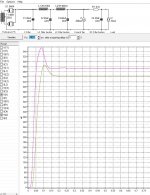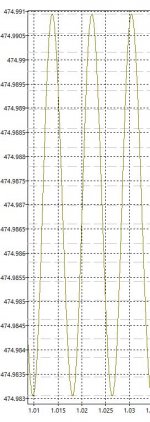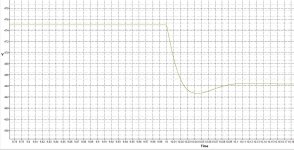looking to build a 450v power supply. has to supply 230mA for 2x kt120 and 2x el84.
so looking at a 400-0-400 325mA transformer, then one CLCLC for both KT120's of 20uF, 2H 18ohm, 40uF, 5H 60ohm, 60uF.
The el84's will be powered by a RC of 1K and 20uF tapped off the last 60uf in the PS.
Sim'd it in PSUD and got 470v for KT120's and 440v for the el84's.
Thoughts?
so looking at a 400-0-400 325mA transformer, then one CLCLC for both KT120's of 20uF, 2H 18ohm, 40uF, 5H 60ohm, 60uF.
The el84's will be powered by a RC of 1K and 20uF tapped off the last 60uf in the PS.
Sim'd it in PSUD and got 470v for KT120's and 440v for the el84's.
Thoughts?
Attachments
Any input? Is this a good power supply for a SE KT120 amplifier? Thank you for any help with this!
Thanks!
Thanks!
Make I2 a stepped load and step it to 500mA and see what happens.
I think you can increase the value of C3 if you really wanted to.
I think you can increase the value of C3 if you really wanted to.
From a stepped load (10% would be more realistic) you can deduct the PS impedance by deviding delta E by delta I. What is the ripple voltage at C3? If you want to run penthodes as triodes you better keep ripple below 5mV. In case 470V is too high you can add a small resistance inbetween the rectifier and C1. That saves the rectifier as well from too large charge currents. Any added resistance 'softens' the PS, allowing more sag. To counteract that you could use heftier iron for the chokes and increase C3 value, usually bringing higher copper resistance to the PS (and thus lowering output voltage).
Last edited:
i tried a 240ma and a 42ma stepped load on the PS. just a small undershoot then levels to the lower voltage. i attached a pic of the 200 to 240mA.
This was at about 10seconds. Looks like it levels off around 160mS later.
The 32 to 42ma step had the same shape and similar recovery time.
This was at about 10seconds. Looks like it levels off around 160mS later.
The 32 to 42ma step had the same shape and similar recovery time.
Attachments
5AR4 has a 825mApk continuous rating - your design sims a 1.2Apk. Similarly, there is also a 3.7A transient peak rating and your design sims about 4.0Apk.
Did you measure the PT primary and half-secondary resistances, and insert them in the PSUD2 calculator for the 20 ohm effective secondary resistance? Did you measure the ESR of the chokes?
Did you measure the PT primary and half-secondary resistances, and insert them in the PSUD2 calculator for the 20 ohm effective secondary resistance? Did you measure the ESR of the chokes?
No I didn't as I don't know what they are. It's the Edcor 400-0-400 325 mA power transformer. The chokes are also Edcor.
It looks like you may need to modify your rectifier arrangement as that total circuit needs a lot more series resistance to allow a 5AR4, and that extra series resistance would drop your B+ significantly.
I've never used those motor run caps, but is it wise to exceed the 440V rating? I also don't like the over-shoot at start-up. It can usually be tamed by reducing the value of C1 to 1-5uF. I'm cheap and like my amps to be small, so I typically use CLC only (not CLCLC) which seems to work well enough. YMMV tho
Edit to say, I have found that the PSU2 values always come out low, so actual voltages will be higher by a fair bit. I would therefore recommend selecting components with plenty of margin for max voltage.
Edit to say, I have found that the PSU2 values always come out low, so actual voltages will be higher by a fair bit. I would therefore recommend selecting components with plenty of margin for max voltage.
Last edited:
I found that PSUD2 values are spot on when you insert the proper transformer properties like the PT primary and half-secondary resistances.
As stated, that is not my experience, even when the correct transformer properties has been entered. The main point though is to allow a healthy margin for your cap voltage rating, say about 20-25% at a minimum is what I usually try and aim for.
Pblix...... motor run capacitors are rated at 440 volts AC which will work out to 1.4 x 440 or 600+ volts DC and will handle LOTS of ripple (5 to 10 amps or more depending on size)
Very useful for the first cap in a clc or crc filter
Very useful for the first cap in a clc or crc filter
Last edited:
- Home
- Amplifiers
- Tubes / Valves
- please critique my power supply.


